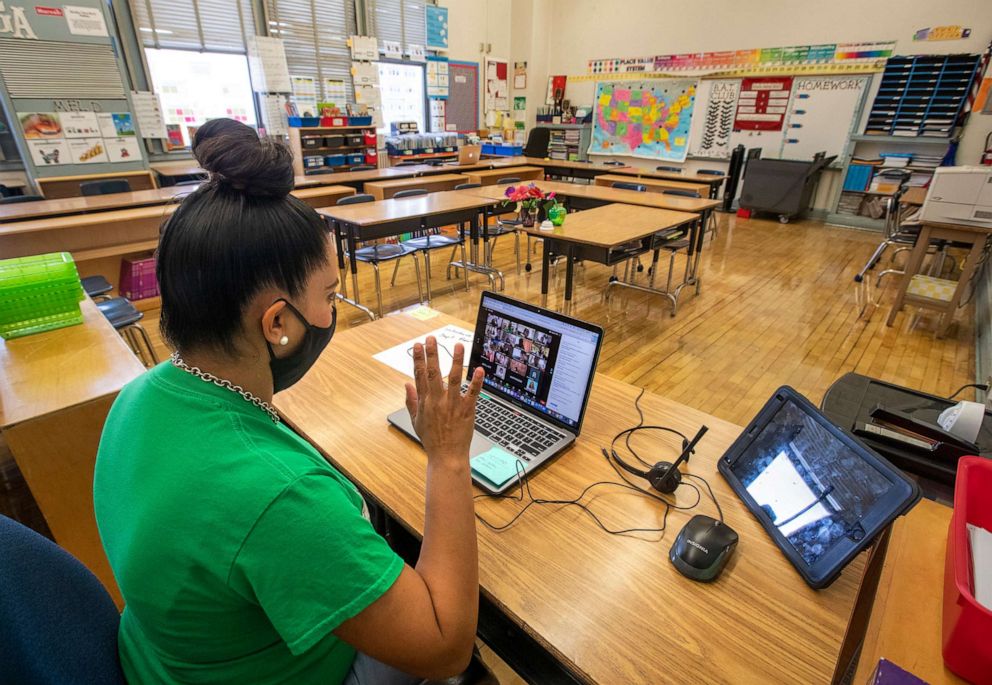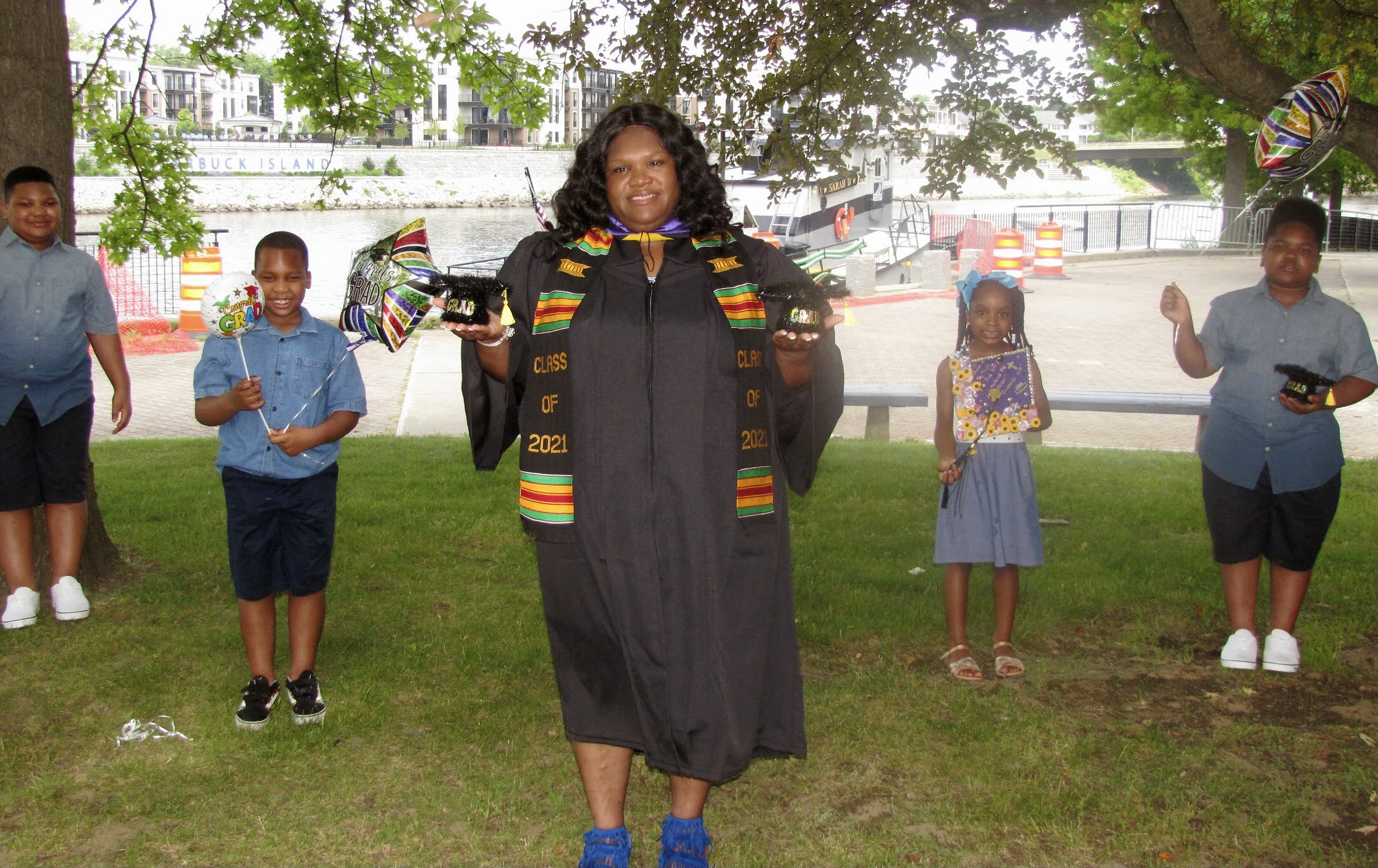As delta variant surges, remote learning in the spotlight for another school year
COVID-19 continues to complicate the education landscape.
Rhashonna Cosby's two children fared very differently during their months of remote learning. Her son thrived working independently, going on to graduate from high school in the spring of 2020. Her 17-year-old daughter, meanwhile, struggled academically without face-to-face instruction, before transferring this past spring to a school where she could go on-site a few days each week.
"She definitely needs in-person," Cosby, of Linden, New Jersey, told ABC News. "That's ideal for her because she doesn't get distracted. She can focus."
As students head back for a third school year impacted by the pandemic, COVID-19 continues to complicate the education landscape and the impact of remote learning has yet to be fully assessed. As achievement gaps have emerged, many districts are planning to return fully in person learning in hopes of restoring traditional learning, even as safety concerns mount around the highly contagious delta variant.
But remote learning will remain a part of students' lives for the foreseeable future, experts say, with tens of thousands of students in quarantine just weeks into the school year for some. How schools approach remote learning is varied: While some view it as a Zoom extension of the classroom, others are taking novel and holistic approaches to try to improve the quality of instruction.
For now, in-person learning is the only option for students like Cosby's daughter, a rising senior, as New Jersey's governor was among several leaders to require full-time, in-person K-12 instruction this school year. Other large school districts, like New York City, are starting the year without a remote option.
In recent days, however, the New Jersey state education department has issued guidance that "strongly encouraged" schools to provide remote instruction for students during quarantine, NorthJersey.com reported.
In Philadelphia, Maritza Guridy had the option of a fully remote school, though she decided to have her four children in person "as long as it's safe," she told ABC News. Once they were able to return to the classroom last school year, her children did better with face-to-face instruction, she said. While working as the secretary for her children's school, Guridy heard from many parents struggling with remote learning last year.
"I got many phone calls with families telling me that they had to choose between working or being able to help their child, so there are children that didn't even log on the entire school year, as a result, because their families could not afford to be at home," said Guridy, who now works as the Northeast Regional Organizer for the education advocacy group National Parents Union. "It was just so many things that I personally experienced, saw, heard about from parents calling the school. It was a lot."
Achievement gap in math and English
While some students may do well learning remotely, others have fallen disproportionately behind.
A spring report by the think tank Rand Corp. found that fully remote students learned less in mathematics and English language arts and were more likely to be absent than those learning in person. In a new poll from the Kaiser Family Foundation, nearly 40% of parents of school-age children said their child fell behind academically during the pandemic -- with Hispanic parents and households with incomes less than $40,000 a year most likely to report that.
Even for those opting for in-person classes, virtual learning will be inevitable this school year, especially in areas of low vaccination, Daniel Domenech, executive director of AASA, the School Superintendents Association, told ABC News.
Case in point: Just a week into the school year, over 10,000 students and staff in one Florida school district were isolating or quarantining due to COVID-19 cases or exposure.
And over 20,000 students in Mississippi, the state with the lowest vaccination rate, were in quarantine after the first week of school.
"Remote learning is not going to disappear," Domenech said. "It's going to continue as a major supplement to help us catch up with the learning loss."

Deliberate about who goes remote
Amid rising worries over the delta variant, Kenny Rodrequez, the superintendent of the Grandview C-4 School District in Grandview, Missouri, has seen a growing interest in remote learning ahead of the first day of school on Aug. 23 -- from about 5% of the district's roughly 4,000 students last month to around 10 to 12%, he told ABC News last week.
"Certainly the variant has many people very concerned," he said, though the district is encouraging in-person learning if possible.
"We're trying to do it a little bit more deliberately this time, a little bit more in the student's best educational interests," he said. "If your kid was virtual last year and they were not successful, we're going to have a real, personal conversation with you about, maybe this is not in their best interest."
For parents concerned about safety, the district has been communicating about its COVID-19 protocols, such as requiring students and staff to wear masks regardless of vaccination status, the superintendent said.
As for remote instruction, the district took a few more lessons to heart. For one, teaching both in-person and remote at the same time was too challenging, so it is looking to have educators who just focus on remote learning. Additionally, teaching kindergarten in particular was too difficult via a screen, so the grade will only be in person this school year, Rodrequez said.
Dedicated virtual staff and a targeted student approach have factored into other school districts' plans. Georgia's Bibb County School District marked the debut this month of its virtual school, VIP Academy -- an investment in remote learning that was in the works pre-pandemic. About 2% of the 21,000-person student body is enrolled in the school, which serves grades 4 through 12, school officials said.
Students had to apply to the school "to make sure that they are a quality candidate to be successful in virtual learning," Rose Powell, chief information officer for the school district, told ABC News. "It's not for everyone."
In the event students attending school in-person in the district aren't able to show up -- such as due to COVID-19 quarantine or isolation, another illness or a family matter -- they can shift virtually at their district school. Classrooms are also equipped with audio and video technology, so teachers can record and upload lessons into the district's learning management system.
"[This] provides our teachers and our students and our parents access like they've never had before," Powell said.

Communication key in unclear environment
One key component during months of pandemic learning has been, simply, communication.
"You cannot communicate enough, because people do not necessarily know what's going on," said Rodrequez, who started posting weekly videos online for families. "I think for us, just trying to be as open and honest as possible and communicate everything that's going on that we know, knowing that sometimes we're not gonna know what's gonna happen -- some things will change around us and we'll have to adapt to that as well."
That captures what many parents are feeling as the school year starts amid high COVID-19 transmission across most of the United States.
Debra Garrett of Troy, New York, is hoping her four children, who are between the ages of 7 and 11, can safely stay in school after they largely learned remotely last year.
"This year was a struggle, but I think a lot of the sacrifices fell on me as a parent, and of course other parents can vouch for that as well," said Garrett, who left her job working for the state's retirement system to be home with her children. She also was in school virtually herself, recently graduating with a bachelor's in health sciences.

Her children did better academically and socially with face-to-face instruction, especially her 10-year-old, she said. After he went back to the classroom a few days a week to receive speech therapy services, he improved so much he currently doesn't need them this upcoming school year, she said.
As cases continue to rise in her area, though, Garrett is getting more anxious about both the prospects of staying fully in-person once her children go back to their charter school on Aug. 23, and what it means for their safety.
"I'm nervous, but I really want them back in the building," she said. "I know that they learn better when they're there. I also need a sense of normalcy."




